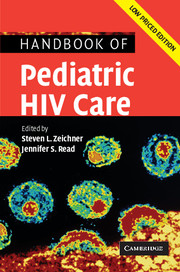Book contents
- Frontmatter
- Contents
- List of contributors
- List of abbreviations
- Foreword
- Preface
- Part I Scientific basis of pediatric HIV care
- Part II General issues in the care of pediatric HIV patients
- Part III Antiretroviral therapy
- Part IV Clinical manifestations of HIV infection in children
- 18 Cutaneous diseases
- 19 Neurologic problems
- 20 Ophthalmic problems
- 21 Oral health and dental problems
- 22 Otitis media and sinusitis
- 23 Cardiac problems
- 24 Pulmonary problems
- 25 Hematologic problems
- 26 Gastrointestinal disorders
- 27 Renal disease
- 28 Endocrine disorders
- 29 Neoplastic disease in pediatric HIV infection
- Part V Infectious problems in pediatric HIV disease
- Part VI Medical, social, and legal issues
- Appendix 1 Formulary of antiretroviral agents
- Appendix 2 National Institutes of Health sponsored clinical trials for pediatric HIV disease
- Appendix 3 Selected HIV-related internet resources
- Appendix 4 Selected legal resources for HIV-infected children
- Index
- References
18 - Cutaneous diseases
Published online by Cambridge University Press: 23 December 2009
- Frontmatter
- Contents
- List of contributors
- List of abbreviations
- Foreword
- Preface
- Part I Scientific basis of pediatric HIV care
- Part II General issues in the care of pediatric HIV patients
- Part III Antiretroviral therapy
- Part IV Clinical manifestations of HIV infection in children
- 18 Cutaneous diseases
- 19 Neurologic problems
- 20 Ophthalmic problems
- 21 Oral health and dental problems
- 22 Otitis media and sinusitis
- 23 Cardiac problems
- 24 Pulmonary problems
- 25 Hematologic problems
- 26 Gastrointestinal disorders
- 27 Renal disease
- 28 Endocrine disorders
- 29 Neoplastic disease in pediatric HIV infection
- Part V Infectious problems in pediatric HIV disease
- Part VI Medical, social, and legal issues
- Appendix 1 Formulary of antiretroviral agents
- Appendix 2 National Institutes of Health sponsored clinical trials for pediatric HIV disease
- Appendix 3 Selected HIV-related internet resources
- Appendix 4 Selected legal resources for HIV-infected children
- Index
- References
Summary
The skin of HIV-infected individuals, both young and old, is a major target organ for numerous infectious, inflammatory, and neoplastic processes. Thus, dermatologists and other clinicians who are adept at diagnosing and treating skin diseases play an extremely important role in the overall care of these patients. For example, many HIV-infected individuals are unaware of their serologic status and present initially with a dermatologic complaint (e.g., the rash of primary HIV infection, herpes zoster). It is thus the responsibility of the astute clinician to inquire about underlying HIV infection. For children, a pediatrician or dermatologist may be the first to suggest HIV disease when evaluating a baby with a particularly recalcitrant case of diaper dermatitis. A second important role for those evaluating the skin of HIV-infected patients is in the recognition of cutaneous clues that are signs of severe systemic infection or cancer (e.g., cutaneous lesions of cryptococcosis or disseminated candidiasis). Prompt and accurate diagnosis through biopsy and microscopic examination of the skin may be life-saving in these types of cases. Lastly, clinicians caring for patients with skin diseases associated with HIV disease may provide tremendous symptomatic relief to their patients by correctly diagnosing and treating particularly severe conditions, such as generalized pruritus, widespread genital warts, or numerous disfiguring lesions of molluscum contagiosum on the face.
As with adults, the majority of the cutaneous manifestations of HIV disease are observed in children with greater degrees of immunosuppression [1–4].
- Type
- Chapter
- Information
- Handbook of Pediatric HIV Care , pp. 473 - 502Publisher: Cambridge University PressPrint publication year: 2006

